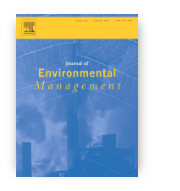From invasive species stand to species-rich grassland: Long-term changes in plant species composition during Solidago invaded site restoration
Sebastian Świerszcz; Marta Czarniecka-Wiera; Tomasz H. Szymura; Magdalena Szymura
Journal of Environmental Management
Ministerial score = 200.0
Journal Impact Factor (2023) = 8.7 (Q1)
 Biological invasions degrade ecosystems, negatively affecting human well-being and biodiversity. Restoration of invaded agricultural ecosystems is among specific goals of European Union Biodiversity Strategy. Successful restoration of invaded lands is a long-term process that requires monitoring to assess the effects of interventions. Here, we present the results of a long-term experiment (8 years) on restoration of semi-natural grassland on abandoned arable field overgrown by invasive Solidago species (S. gigantea and S. canadensis). We examined effect of different invaders removal methods (rototilling, turf stripping, herbicide application) and seed application practices (commercial seed mixture, fresh hay) on changes in species composition and taxonomic diversity of restored vegetation. Our results showed a positive effect of grassland restoration on taxonomic diversity and species composition, manifested by a decrease in Solidago cover and an increase in cover and richness of target graminoids and forbs characteristic of grassland. The seed source had a longer lasting and still observable effect on the vegetation composition than the Solidago removal treatments, which ceased to differ significantly in their influence after the first few years. Applying fresh hay as a seed source increased the cover of grassland species such as Arrhenatherum elatius and Poa pratensis. For commercial seed mixture, we observed the high cover of Lolium perenne and Schedonorus pratensis (introduced with seed mixture) at the beginning and the slow decrease along the experiment course. The most striking effect was the fresh hay with herbicide application, which resulted in the lowest Solidago cover and the highest cover of target graminoids. Nonetheless, with years the non-chemical methods, including no treatment, gives comparable to herbicide effectiveness of restoration. Overall, during the experiment, alpha diversity increased, while beta and gamma diversity reached a species maximum in the third year, and then decreased. In conclusion, this study gives guidance to successful restoration of species-rich grasslands on sites invaded by Solidago. It should be emphasised that short-term effect differ considerably from long-term outputs, especially highlighting the importance of seed source, as well as effectiveness of environmentally friendly methods such as regular mowing to control the invader.
Biological invasions degrade ecosystems, negatively affecting human well-being and biodiversity. Restoration of invaded agricultural ecosystems is among specific goals of European Union Biodiversity Strategy. Successful restoration of invaded lands is a long-term process that requires monitoring to assess the effects of interventions. Here, we present the results of a long-term experiment (8 years) on restoration of semi-natural grassland on abandoned arable field overgrown by invasive Solidago species (S. gigantea and S. canadensis). We examined effect of different invaders removal methods (rototilling, turf stripping, herbicide application) and seed application practices (commercial seed mixture, fresh hay) on changes in species composition and taxonomic diversity of restored vegetation. Our results showed a positive effect of grassland restoration on taxonomic diversity and species composition, manifested by a decrease in Solidago cover and an increase in cover and richness of target graminoids and forbs characteristic of grassland. The seed source had a longer lasting and still observable effect on the vegetation composition than the Solidago removal treatments, which ceased to differ significantly in their influence after the first few years. Applying fresh hay as a seed source increased the cover of grassland species such as Arrhenatherum elatius and Poa pratensis. For commercial seed mixture, we observed the high cover of Lolium perenne and Schedonorus pratensis (introduced with seed mixture) at the beginning and the slow decrease along the experiment course. The most striking effect was the fresh hay with herbicide application, which resulted in the lowest Solidago cover and the highest cover of target graminoids. Nonetheless, with years the non-chemical methods, including no treatment, gives comparable to herbicide effectiveness of restoration. Overall, during the experiment, alpha diversity increased, while beta and gamma diversity reached a species maximum in the third year, and then decreased. In conclusion, this study gives guidance to successful restoration of species-rich grasslands on sites invaded by Solidago. It should be emphasised that short-term effect differ considerably from long-term outputs, especially highlighting the importance of seed source, as well as effectiveness of environmentally friendly methods such as regular mowing to control the invader.
DOI:10.1016/j.jenvman.2024.120216









